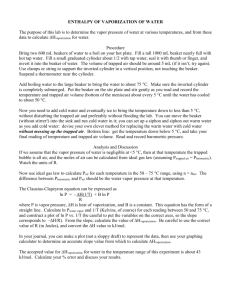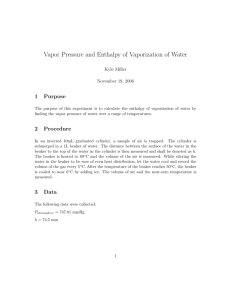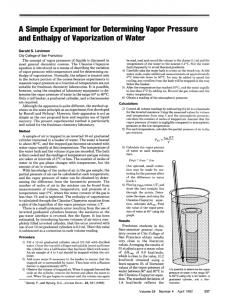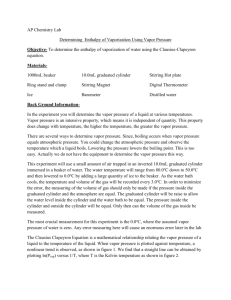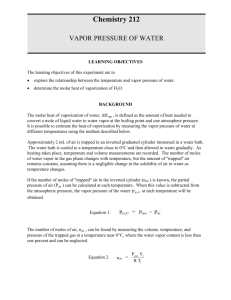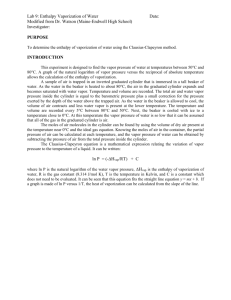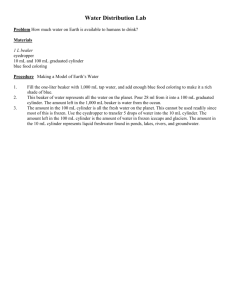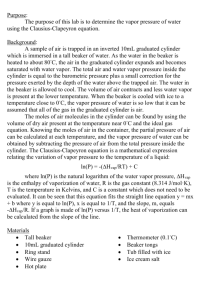Enthalpy of Vaporization of Water
advertisement
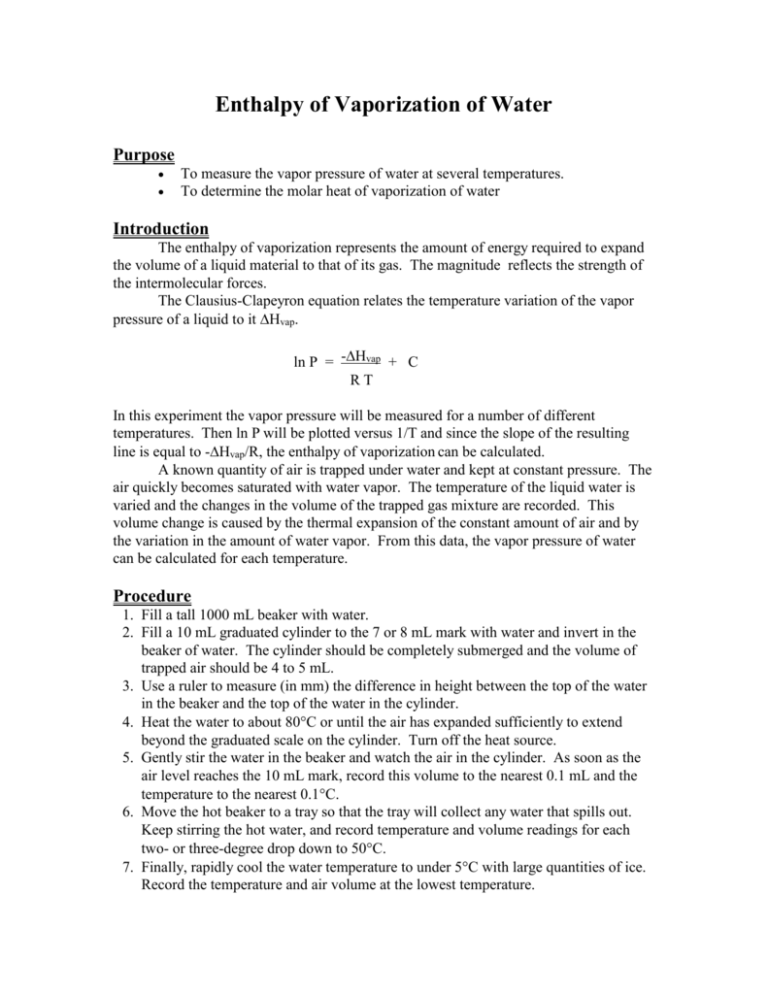
Enthalpy of Vaporization of Water Purpose To measure the vapor pressure of water at several temperatures. To determine the molar heat of vaporization of water Introduction The enthalpy of vaporization represents the amount of energy required to expand the volume of a liquid material to that of its gas. The magnitude reflects the strength of the intermolecular forces. The Clausius-Clapeyron equation relates the temperature variation of the vapor pressure of a liquid to it Hvap. ln P = -Hvap + C RT In this experiment the vapor pressure will be measured for a number of different temperatures. Then ln P will be plotted versus 1/T and since the slope of the resulting line is equal to -Hvap/R, the enthalpy of vaporization can be calculated. A known quantity of air is trapped under water and kept at constant pressure. The air quickly becomes saturated with water vapor. The temperature of the liquid water is varied and the changes in the volume of the trapped gas mixture are recorded. This volume change is caused by the thermal expansion of the constant amount of air and by the variation in the amount of water vapor. From this data, the vapor pressure of water can be calculated for each temperature. Procedure 1. Fill a tall 1000 mL beaker with water. 2. Fill a 10 mL graduated cylinder to the 7 or 8 mL mark with water and invert in the beaker of water. The cylinder should be completely submerged and the volume of trapped air should be 4 to 5 mL. 3. Use a ruler to measure (in mm) the difference in height between the top of the water in the beaker and the top of the water in the cylinder. 4. Heat the water to about 80C or until the air has expanded sufficiently to extend beyond the graduated scale on the cylinder. Turn off the heat source. 5. Gently stir the water in the beaker and watch the air in the cylinder. As soon as the air level reaches the 10 mL mark, record this volume to the nearest 0.1 mL and the temperature to the nearest 0.1C. 6. Move the hot beaker to a tray so that the tray will collect any water that spills out. Keep stirring the hot water, and record temperature and volume readings for each two- or three-degree drop down to 50C. 7. Finally, rapidly cool the water temperature to under 5C with large quantities of ice. Record the temperature and air volume at the lowest temperature. Enthalpy of Vaporization of Water Calculations 1. The 10 mL cylinder is graduated to give correct volume readings only when right side up. This is due to the shape of the water meniscus. Subtract 0.2 mL from each of your readings to correct for this effect. 2. Calculate the total pressure of the gas in the cylinder from the barometric pressure and the difference in water levels between the top of the water in the beaker and the top of the water inside the cylinder. PT = Pbar + difference in levels/13.5 3. Calculate the moles of trapped air by using the volume of air present at the lowest temperature. At this low temperature, the vapor pressure of water is negligible. PTV=nairRT 4. For each temperature above the lowest one, calculate the partial pressure of air in the cylinder, using the constant moles of gas calculated in # 3. PairV=nairRT 5. Calculate the vapor pressure of water at each temperature. Pwater= PT - Pair 6. Plot ln Pwater on the vertical axis versus 1/T on the horizontal axis. Use linear regression to determine the equation of the line. 7. Calculate the value of Hvap. 8. Calculate the percent error. Data Barometric Pressure ___________ Difference in height ___________ Temperature (C) Volume (mL) Enthalpy of Vaporization of Water Results 2 3 Corrected Volume (mL) Total pressure in cylinder Moles of trapped air Temp (K) Pair (atm) 6 7 8 Pwater (atm) 1/T (1/K) ln Pwater Regression Eqn Hvap Percent error Questions 1. You have assumed the vapor pressure of the water below 5C to be negligible. Look up the actual value and tell how its inclusion would have affected your calculated results. 2. Write out the long “two-point” form of the Clausius-Clapeyron equation. Why does the graphical method of analysis give a better value for the enthalpy of vaporization than does the form of the Clausius-Clapeyron equation using two temperature-vapor pressure values?
